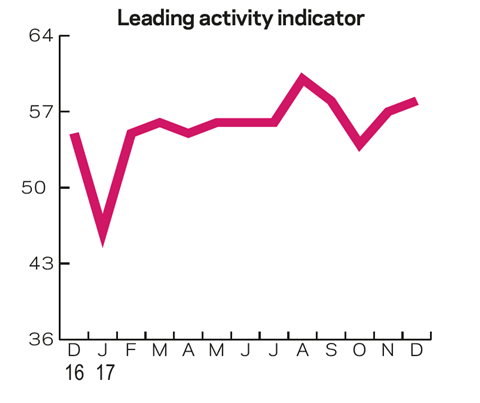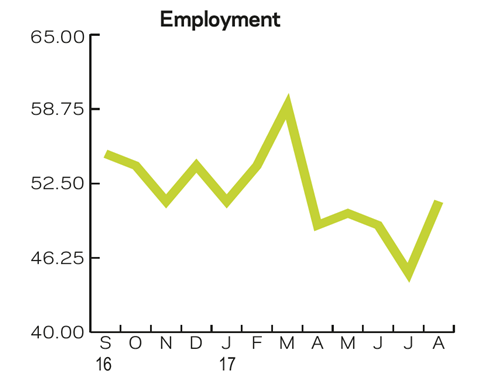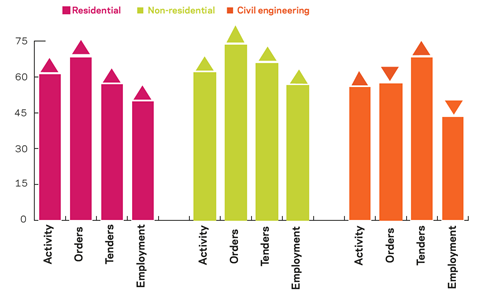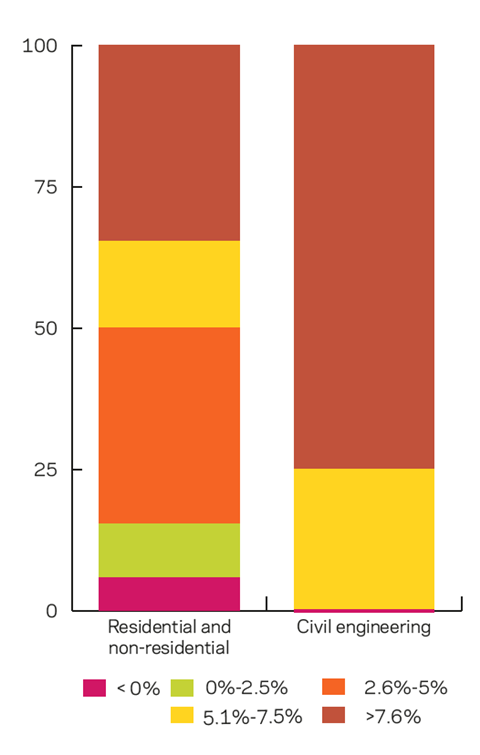The total activity index rose by four points in August. The R&M index fell by a point, staying just inside positive territory, and the orders index jumped up from July’s figure. Experian Economics reports
01 / State of play
The total activity index rose by four points in August and reached 60, moving away from the average level of 56 since the start of the year. The repair and maintenance (R&M) activity index slipped down one point to 51, remaining just in positive territory. All three sectors expanded in August, with each index over 50. Residential activity grew by five points to 61, the highest value since September 2016.
The non-residential activity index increased by six points, reaching 62, the highest figure since January 2015. The civil engineering activity grew by three points and stood at 56. Both residential and non-residential orders indices rose and remained firmly on the expansion side. The former stood at 68 points – its highest since February, whereas the latter was at 73. Civil engineering orders grew more slowly than in the previous month, as the index decreased from 68 to 57. On a sectoral basis, tender enquiries increased in all three sectors.
The residential index grew by three points to 57 and the non-residential and the civil engineering indices both jumped, by 10 points to 66, and 11 points to 68, respectively. The tender prices index grew by three points, reaching 65. The figure remains lower than the average for 2017 (68), but is still up from last month’s one-year low. The employment prospects index showed a recovery following four months of contraction. The index stood at a marginally positive 51 – the highest since March.
Results from the September survey suggest some easing of activity constraints. Respondents reporting no constraints reached 44%, indicating a recovery from last month’s low. Respondents indicated that insufficient demand is still the largest constraint, followed by labour and materials shortages.
But the percentage of respondents reporting both these factors as constraints on activity fell in August, by 4% in the case of labour shortages and 3% in the case of finance. The current figure of 5% for financial constraints is the lowest since December 2016.
02 / Leading construction activity indicator
September’s survey indicated expansion in contractors’ activity, with the index jumping to 60: a four-point increase, above the stable levels around 55 seen since February. The expectations are, however, for a slight drop below 60 in the following months, with an average level of 57.




03 / Material costs
The results from the September survey indicate rising cost pressures, with an increasing proportion of respondents facing rising material costs of more than 5%, compared with those facing rising material costs of below 2.5%. This is perhaps unsurprising in light of recent UK inflation figures.
The trend emerging in the residential and non-residential sectors is more apparent in the civil engineering sector. Since May 2017, the proportion of respondents in the latter sector indicating rising material costs above 5% is increasing, and the latest survey results show that three-quarters of respondents faced costs rising by more than 7.5%.

04 / Regional perspectives
Experian’s regional composite indices incorporate current activity levels, the state of order books and the level of tender enquiries received by contractors, to provide a measure of the relative strength of each regional industry.
The latest survey results show expansion in seven regions, but only two regions reported positive changes in their indices in August: Wales and the South-west. The North-east showed the strongest index, of 61, although this represented a drop compared with the previous month. Next was Yorkshire and Humber with an index of 55, followed by a number of regions clustered in the low 50s – Northern Ireland, the North-west, East Anglia, the South-east and the South-west. Wales showed the biggest increase in its index, up five points to 47, but it still remained below the 50 no-change mark.
On the positive side, Wales showed the largest increase – up five points to 47, compared with the South-west’s marginal uptick of one point to 53.
The UK composite index recorded a five-point fall to 44. This marks the lowest value since September 2016 and is the second consecutive month on negative territory.

This an extract from the monthly Focus survey of construction activity undertaken by Experian Economics on behalf of the European commission as part of its suite of harmonised EU business surveys. The full survey results and further information on Experian Economics’ forecasts and services can be obtained by calling 0207-746 8217 or logging on to www.experian.co.uk/economics.
The survey is conducted monthly among 800 firms throughout the UK and the analysis is broken down by size of firm, sector of the industry and region. The results are weighted to reflect the size of respondents. As well as the results published in this extract, all of the monthly topics are available by sector, region and size of firm. In addition, quarterly questions seek information on materials costs, labour costs and work-in-hand.
CFR’s leading construction activity indicator incorporates a range of factors to assess the construction industry’s prospects over the next quarter. The indicator is put together using information about past levels of activity, orders and tender enquiries.







No comments yet